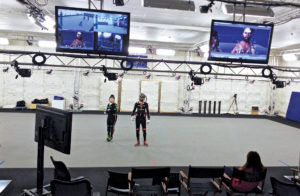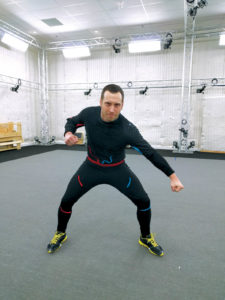Ubisoft and OCAD University students worked together to advance the technology of the motion capture suit.
Ubisoft, a leading creator, publisher and distributor of interactive entertainment and services, is behind some of the world’s most recognizable game brands, including Assassin’s Creed, Tom Clancy’s Ghost Recon and Watch Dogs, and more recently has launched Ubisoft Motion Pictures. Its first film, Assassin’s Creed, produced by Michael Fassbender, was scheduled for release in December 2016. The company has established a reputation for delivering original and innovative content as narrative, visuals and action converge to enhance the user and viewer’s experience.
Key to the action is the use of Ubisoft Toronto’s performance capture studio, which allows actor performances to be captured, digitized and applied onto digital characters: this includes simultaneous capture of body performance, facial nuances, dialogue and sound. While games and movie special effects have grown increasingly sophisticated and technically challenging, motion capture (“mocap”) suits worn by the actors have evolved little. To find ways to further refine the suit, Ubisoft put the challenge to Digital Futures students at Ontario College of Art and Design (OCAD) University in Toronto, Canada, the city in which one of their studios, Ubisoft Toronto, is based. Students worked with tutors Immony Men (a visual artist currently based in Montreal) and me, with Jenny Boucher providing teaching assistance. The project was included in the undergraduate “Wearables Atelier” course during the winter 2016 semester. The challenges students faced were considerable: technical, performance, ergonomic, comfort and aesthetic.

The motion capture suit is designed to be fitted to the performer’s physique and to allow markers to be placed in key locations on the body, which allows the performance to be captured digitally. Markers can include the entire body or focus on facial features through the use of a head-mounted camera. In movies, the suit allows for special effects and demanding action to take place in studios or relatively small spaces, with the background filled in afterward to allow a hybridization of human and animated facial features. In games, the mocap suit is part of the system used to generate a comprehensive library of actions for each character that the player can draw on in their interactions.
Fabric and technology
The intention of the motion capture suit is to provide some flexibility—but not enough to compromise the position of the markers necessary for recording. The garment is not unlike a wetsuit covering the whole body, with Neoprene or Lycra®-based fabrics used. The markers are small round balls, roughly the size of a dime, covered with a retroreflective material that is detected by the motion capture system. Markers are attached manually to the garment using Velcro® each time the suit is used, with sixty-one markers standard on a suit. This produces the effect needed in the final movie or game. In this student project, the aim was to improve the mocap suit by identifying efficiencies, enhancing ergonomics and increasing comfort for the wearer.
Meeting at the Ubisoft Toronto studio in the west end of the city, students were shown the performance capture studio where the action takes place—literally. A brainstorming session quickly identified three areas of focus: noise, time and ergonomics. Velcro is not especially noisy, but in the context of filming it can be a factor since it can get peeled off the body during action shots. Manually placing the Velcro markers on the suit for each use eats up valuable time and if the markers fall off during the action the scene could become compromised and need to be reshot. If a marker is covered during a shoot and the camera cannot see it, it is referred to as an “occlusion.” The third issue that students prepared to address was one of ergonomics and comfort. Suits are sometimes worn for up to eight hours at a time, with the wearer performing high-action movements constantly under studio lighting and with as many as eight cameras. Designing a more flexible, lighter and comfortable suit was added to the priority list.
Collaboration and action

As part of a broader atelier within an undergraduate curriculum, the motion capture suit project had to address not only the objectives set out by Ubisoft, but also those of the university. Working collaboratively as a student team, as well as with industry, was an important part of the work. Much of the project was done outside the classroom, making scheduling and communication critical. Agreeing on tasks and deliverables meant that each student had to realize that completing each section on time was necessary to the success of the entire design. Meetings, presenting and prototyping with Ubisoft afforded an ideal opportunity for students to develop these professional skills.
Much of the first class of the eleven-week assignment was taken up with examining the motion capture suit, fitting it on and experiencing first-hand how it worked and where refinements might be made. Students decided that an alternative to Velcro offered a route forward that would address not only the issue of noise but also the time lost as markers become detached during the day of filming. A solution was found in using a light perforated Neoprene with a light jersey base fabric. The holes in the outer rubber were large enough to allow the reflective balls through, but not the fabric to which they were attached. The result was greater stability and flexibility, as well as breathability for the wearer. The team also established that the Neoprene did not need to cover the whole body; a pattern was made using the material only where necessary, and the lighter and more breathable jersey elsewhere.
The final garment looked very different from the conventional motion capture suit, but in trials with a professional stuntman it worked extremely well. As a first iteration the project proved that the concept could work, and usefully highlighted where further refinements might be made. For Ubisoft, the initiative offered a chance not only to find a solution, but also to see the capabilities of students whose skills set includes games as well as wearable technology. For the students, they now have some project work that gave them the challenge of real-life problems and took them well beyond the classroom, with an outcome that they can include in their portfolios. And yes—they did get to play some awesome video games in the process.
 TEXTILES.ORG
TEXTILES.ORG



 OCAD students redesigning the motion capture suits used both hand drawing and digital tools, acknowledging that in a digital age both skills are needed. For Ubisoft, the initiative was an opportunity not only to find a solution, but also to see the capabilities of students whose skill set includes games as well as wearable technology. For the students, they now have some experience working on real-life projects and problems.
OCAD students redesigning the motion capture suits used both hand drawing and digital tools, acknowledging that in a digital age both skills are needed. For Ubisoft, the initiative was an opportunity not only to find a solution, but also to see the capabilities of students whose skill set includes games as well as wearable technology. For the students, they now have some experience working on real-life projects and problems.